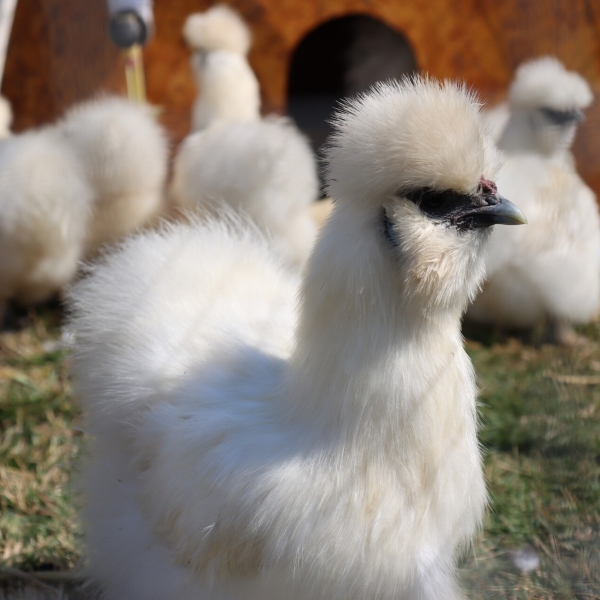The Silkie Bantam is a popular ornamental breed with a long and fascinating history. Believed to have originated in ancient Asia, it was first described by early European travellers who were captivated by its fur-like feathers and unusual features. Silkies have remained a favourite worldwide due to their unique appearance and gentle personality.
Egg Production
Silkie hens are not prolific layers. They typically produce between 100-120 small cream or white eggs per year. They often start laying later than most breeds, usually between 7-9 months of age. Their strong broody instinct can interrupt laying cycles frequently, which makes them less reliable as consistent egg producers.
Appearance
Silkies are known for their soft, fluffy plumage that resembles fur rather than feathers. This is because their feathers lack the barbs that hold them together, giving the birds a distinctive silky look. Other unique features include black or bluish skin and bones, turquoise-blue earlobes, a walnut-shaped comb, and five toes on each foot, instead of the usual four. Silkies come in a range of colours, including white, black, buff, blue, and partridge, and are compact in size with rounded bodies.
Temperament and Behaviour
Silkies are among the calmest and most friendly chickens. They are ideal for families with children and do well in small backyard flocks. Their docile nature enables them to integrate easily with other gentle breeds. While they are not particularly energetic or flighty, they are very social and enjoy human interaction.
Broodiness and Mothering
One of the standout traits of Silkie hens is their exceptional broodiness. They frequently go broody and make some of the best natural mothers in the poultry world. They are commonly used to hatch eggs from other chickens and even other species such as ducks and quail. Their gentle nature makes them highly attentive and protective mothers.
Care and Management
Due to their feather structure, Silkies are not waterproof and should be protected from wet and muddy conditions. A dry, well-sheltered coop is essential to keep them healthy and comfortable. Their feathered feet can collect dirt and debris, so regular inspection is helpful. Because they do not fly well, they are easier to confine, but this also makes them more vulnerable to predators.
Suitability and Use
Silkie Bantams are best suited for keepers looking for a friendly, ornamental bird. They are not productive egg layers or meat birds, but their personality and appearance make them a favourite for exhibition, pets, and natural incubation roles. Their calm temperament also makes them a good choice for schools or therapy animal programmes.
Summary
Silkie Bantams are beloved for their unique combination of beauty and personality. They offer:
-
Between 100-120 small cream or white eggs per year
-
Late onset of lay, usually at seven to nine months
-
Unusual physical traits such as soft plumage, black skin, and five toes
-
Gentle, friendly temperament ideal for families and children
-
Excellent broodiness and mothering skills
-
Special care needs related to their feathers and housing environment
Silkies are an excellent addition to any flock where companionship and ornamental value are prioritised.
Silkie Bantam
- Product Code: 450-0160
- Availability: Call For Availability
-
R0.00
Tags: Silkie Bantam

